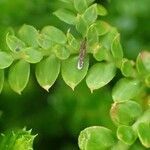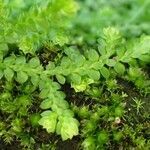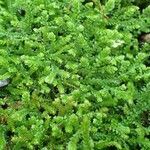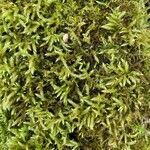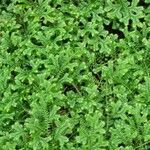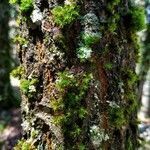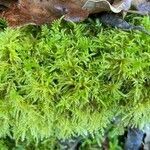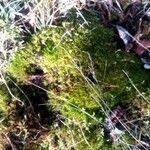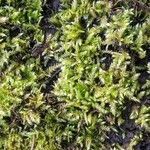Plants terrestrial or epilithic. Stems herbaceous, epigeal, wide-creeping, rooting at branching points, anisotomously branched, anisophyllous, forming loose mats, terete, to 1 mm in diameter, primary branches prostrate or ascending, to 1 mm in diameter, anisophyllous, heterophyllous. Leaves pale green, spaced to imbricate, herbaceous to thinly herbaceous, median leaves dorsally in 2 ranks, sessile, lanceolate to ovate-lanceolate, the base inequilateral, the outer lobe largest, serrulate, the midrib raised adaxially, glabrous, to 2.6 mm long, to 1 mm wide, lateral leaves more or less patent, sessile, oblong-elliptic, the base inequilateral, the acroscopic lobe largest, serrulate, the midrib raised adaxially, to 3.2 mm long, to 1.5 mm wide. Strobili sessile, solitary at the apex of secondary and lower order branches, to 17 mm long, isophyllous, sporophylls ephemeral, isophyllous, herbaceous, lanceolate to lanceolate-ovate, carinate, serrulate, to 1.6 mm long, to 0.6 mm wide. Sporangia subtended by a membranous, ovate ligule, spheroidal, megasporangia sessile, in axil of sporophylls, isovalvate, to 0.5 mm in diameter, subtended by a membranous oblong ligule, to 0.2 mm long, microsporangia short-stalked. Megaspores basal in strobilus, pale yellow, 4 per sporangium, globose, trilete, perispore cristate, reticulate, exospore (544-)572(-608) µm in diameter; microspores yellow, numerous, globose, trilete, echinate, the spine bases joined to form a reticulum of ridges, exospore (34-)36.25(-40) µm in diameter.
Plants terrestrial, forming diffuse mats. Stems long-creeping, branched, branches 3-forked, flat, articulate, glabrous. Rhizophores borne on upperside of stems throughout stem length, 1--3 mm diam. Leaves delicate, papery. Lateral leaves nearly perpendicular to stem, well spaced, green, lanceolate, 2.5--3.6 X 0.8--1.2 mm; base rounded; margins slightly transparent to green, dentate; apex acute. Median leaves lanceolate to linear-lanceolate, 2--2.7 X 0.6--0.8 mm; base with small outer auricle; margins slightly transparent to green, dentate; apex acuminate. Strobili solitary, 0.2--2.5 cm, with only 1 megasporangium, megasporangium basal; sporophylls keeled, dentate, strongly tapering toward apex, base glabrous, margins denticulate, apex acuminate; megasporophylls larger than microsporophylls, in groups of 4, 2 like vegetative leaves, 2 like sporophylls, of the latter 1 large, lanceolate-elliptic, 1 smaller, falcate-lanceolate; microsporophylls lanceolate to narrowly ovate-lanceolate. 2 n = 20.
Plant wide-creeping. Stems up to 0.5 m long, with swollen 'joints' occasionally below furcation of branch. Primary branch systems ovate to broadly elliptic in mature specimens, but branches straggly, interwoven and outline obscured; secondary branches elliptic-lanceolate; tertiary branches 1-to 3-furcate, 10-15 mm long. Leaves heteromorphic: median leaves lanceolate or ovate-lanceolate, 2.5 mm long, apex acute, base cordate, unequal, margins sparsely toothed; lateral leaves subsessile, linear-elliptic, 3-4 x 0.75-1.5 mm, subdimidiate with a pale median line, apex acuminate, margins serrate; axillary leaves similar to lateral leaves, but wider. Strobili infrequently formed at apex of ultimate branches, 0.5-0.8 mm long, maturing simultaneously throughout secondary branch; sporophylls undifferentiated, similar to median leaves but narrower. Megaspores reticulate with thin narrow wings, c. 750 µm. Microspores echinate, 26-32 µm, bases of spines joined to form ridges.
Stems wide-creeping, much-branched, with swollen 'nodes' (sometimes called 'articulations') below each dichotomy, rooting at intervals; branches procumbent. Median leaves narrowly ovate, 2.5 mm long; base symmetrical; margins denticulate; apex attenuate, acute and ±curved away from the stem. Lateral leaves linear-elliptic, 3–4 mm long, 0.75–1.5 mm wide; margins denticulate, rarely partially entire; apex acute. Strobili uncommon, 5–8 mm long; sporophylls monomorphic, ovate-lanceolate, attenuate or with a very acute apex; megasporophylls usually basal. Megaspores c. 550 µm diam., reticulate. Microspores 28–45 µm diam., spiny; spinules 5–10 µm long.
Stems herbaceous, widely creeping, anisotomously branched, forming loose mats, terete, up to 1 mm in diam. Lycophylls ligulate, pale green, spaced to imbricate, herbaceous to thinly herbaceous, median lycophylls sessile, lanceolate to ovate-lanceolate, up to 2.5 x 1 mm, glabrous, lateral lycophylls ± patent, sessile, oblong-elliptic, up to 3.2 x 1.5 mm, serrulate. Strobili heterophyllous, sessile, up to 17 mm long. Sporophylls in 4 ranks, herbaceous, lanceolate to lanceolate-ovate, up to 1.6 x 0.6 mm, carinate, serrulate. Sporangia spheroidal, near axil of sporophylls, isovalvate, up to 0.5 mm in diam.
Stems creeping, irregularly branched, forming a loose mat. Lvs dimorphic, 4-ranked. Lvs of 2 lateral ranks spreading, ovate, acute, finely ciliate, 3-4-(5) mm long, ± uniform throughout, widely spaced except at the apices. Lvs of 2 upper ranks appressed to stem, 2-3 mm long, with more tapering apices. Strobili sessile, lateral, up to 10 mm long; sporophylls markedly smaller than microphylls.
Perennial with prostrate, spreading stems, branched, 1-3-furcate. Leaves herbaceous to thinly herbaceous, anisophyllous, median leaves sparsely toothed, lateral leaves serrate. Strobili at apex of ultimate branches, to 17 mm long, sporophylls carinate, serrulate.
Plant wide-creeping. Leaves of at least secondary branch systems markedly dimorphic. Lateral leaves 3-4 x 0.75-1.50 mm; hyaline teeth of equal lengths around margins of median leaves.
